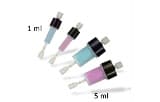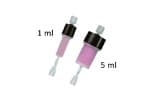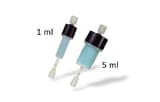
FPLC columns for histidine tagged proteins
Immobilized metal ion affinity chromatography (IMAC) technology was introduced by Porath et al (1975). Certain amino acids such as histidine, tryptophan, cysteine and tyrosine can act as electron donors on the surface of the protein and bind reversibly to a transition metal ion. IMAC purification utilizes this metal ion binding by coupling a chelating group (such as Nitrilotriacetic Acid (NTA) or Iminodiacetic Acid (IDA)) to a stable chromatographic resin (such as Agarose). Transition metal ions such as Ni2+, Co2+, Cu2+, or Zn2+ (see Porath and Olin, 1983; Porath, 1988; Sulkowski, 1989) can then be loaded and immobilised onto the chelating group enabling high affinity binding, in the majority of cases this is via an 6-8x polyhistidinetag engineered at the N- or C-terminus of a recombinant protein (Kd-10-13 at pH 8.0). Nickel and Cobalt are the most widely used metal ions as they confer the highest affinity (Ni2+>Co2+) with the highest specificity (Co2+>Ni2+) for the IMAC tags.
The simplicity of IMAC technology is extremely attractive as it lends itself to a bind-washelute mode of operation if the appropriate buffer formulations are selected. IMAC purification can also be achieved using samples without any prior treatment (e.g. buffer exchange steps). The use of metal chelate affinity is widespread for the selective adsorption of engineered recombinant proteins and has largely superseded non-affinity methods of chromatography for purifying recombinant proteins.



